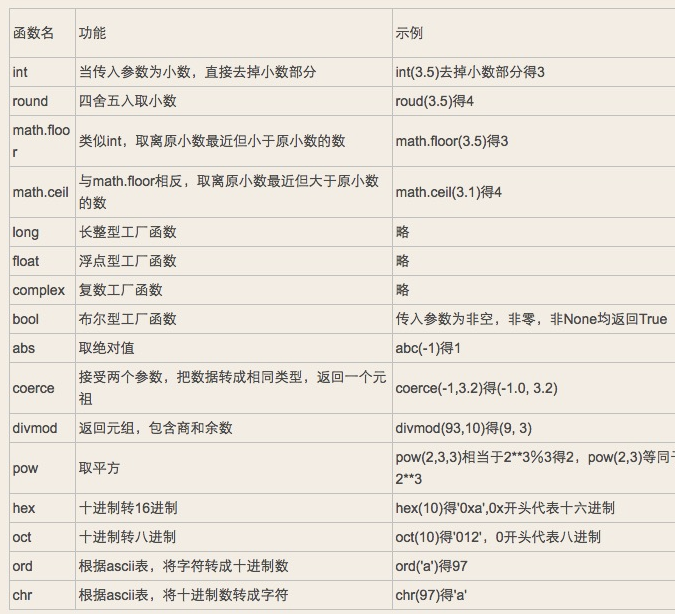一、for循环
1.1功能及语法
for循环是迭代循环机制(while是条件循环),语法如下:
1 for i in a b c: 2 print(i)
1.2典型例子:
1.2.1猜年龄循环

1 realy_age = 30 2 for i in range(3): 3 age = int(input("pls input age:")) 4 if age == realy_age: 5 print("正确!") 6 break 7 elif age > realy_age: 8 print("猜大了") 9 else: 10 print("猜小了") 11 else: 12 print("次数太多了,退出程序")
1.2.2 for基于range用法
range(5)是指0-4顾头不顾尾,例子如下:

1 for i in range(10): 2 print(i) 3 0 4 1 5 2 6 3 7 4 8 5 9 6 10 7 11 8 12 9
1.2.3 for嵌套使用

1 for i in range(10): 2 for j in range(10): 3 if j<6: 4 continue 5 6 print(i,j)
二、while循环
2.1 while功能和语法
while条件循环,满足某一条件下,一直循环,直到不满足,终止。
2.2 while用法举例:
2.2.1 死循环

1 count = 0 2 while True: 3 print("你是风儿我是沙,缠缠绵绵到天涯...",count) 4 count +=1
2.2.2 猜年龄游戏(while用法)

1 count = 0 2 age = 56 3 while count <3: 4 guess_age = input("age:").strip() 5 if guess_age.isdigit(): 6 guess_age = int(guess_age) 7 else: 8 continue 9 if guess_age == age: 10 print("猜对了") 11 break 12 elif guess_age < age: 13 print("往大猜") 14 else: 15 print("往小猜") 16 count +=1
三、数据类型
数字类型包括:数字、字符串、列表、元组、字典
3.1 数字
3.1.1 整型
python中可用十进制、八进制、十六机制

3.1.2 布尔bool
True 和False
1和0
3.1.3 浮点float
在python里面,浮点就是小数,整数和浮点在计算机内部存储方式是不同的,整数运算永远是精确的,浮点运算有四舍五入的误差。
3.1.4数字相关内置函数

3.2字符串
3.2.1 字符串创建
msg = "Hello world" print(msg,type(msg))
执行结果:Hello world <class 'str'>
3.2.2 字符串常用操作
分割、长度、索引、切片、移除空白
3.2.3 字符串常用举例
1 msg='Hello worll' 2 print(msg) 3 print(msg.center(30,"*")) #居中,不够的用*填充 4 print(msg.upper()) #全部大写字母 5 print(msg.lower()) #全部小写字母 6 print(msg.count("l",2,5)) #统计下标从2-5中间l的个数 7 print(msg.ljust(30,"*")) #左对齐,不够的用*填充 8 print(msg.rstrip()) #去掉右边的空格 9 print(msg.strip()) #去掉左右的空格
10 print(len(msg)) #计算长度
3.3列表
3.3.1 列表创建
name_list = ['alex', 'seven', 'eric']
或name_list = list(['alex', 'seven', 'eric'])3.3.2 常用操作
增删改查,代码如下:
1 names = ['alex','liumj','jack','liumj','wangzy','yesky','tmg'] 2 names2 = ['alex','liumj','jack','liumj'] 3 name1 = names.copy() #copy names列表,不同的内存地址 4 names.append('wangxy') #追加元素到列表里面 5 print(names.insert(1,"oldboy")) #在第二个元素前插入oldboy元素 6 print(names.count('liumj')) #统计列表中liumj元素的个数 7 print(names.index('alex')) #获取alex元素的下标索引 8 print(names.remove('jack')) #移除jack元素 9 names.reverse() #反向排序 10 print(names) 11 names.sort() #列表元素排序 12 print(names) 13 names.pop(6) #删除下标为6的元素 14 print(names) 15 print(names.reverse(names2)) 16 names.extend(names2) #把names2追加到names里面 17 print(names)
